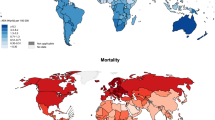Abstract
Trends in melanoma incidence by anatomic site were examined in Canada where ascertainment of cancer has been of a high standard. The analysis included 41,239 malignant melanomas registered between 1969 and 1993 and used an age, period and cohort modeling approach. The estimated annual increase was 4.8% for males and 3.1% for females but slowed appreciably in the later years. The lifetime risk of melanoma appeared to have peaked with women born about 1934 and men born about 1944. The age-standardized rates have now stabilized for women and are expected to plateau for men in the near future. The largest relative increases occurred for the upper limbs followed by the trunk for both sexes. Comparable generation effects were observed for intermittently exposed sites but the patterns of trend differed between sites for men and women. This supports effects due to sex- and site-specific pattern of sun exposure. The evidence, for the first time, of more favorable trends among post-World War II generations is thought to reflect reduced exposure to UV rays. This may possibly be the earliest signs of the impact of primary prevention programs, particularly if UV radiation also acts as a tumor promoter.
Similar content being viewed by others
References
Armstrong BK, Kricker A (1994) Cutaneous melanoma. Cancer Surv 19/20: 219-240.
Boyle P, Maisonneuve P, Doré J-F (1995) Epidemiology of malignant melanoma. Br Med Bull 51: 523-547.
Holman CDJ, James IR, Gattey PH, Armstrong BK (1980) An analysis of trends in mortality from malignant melanoma of the skin in Australia. Int J Cancer 26: 703-709.
Cooke KR, Skegg DC, Fraser J (1983) Trends in malignant melanoma of skin in New Zealand. Int J Cancer 31: 715-718.
Kricker A, Armstrong BK, Jones ME, Burton RC (1993) Health, Solar UV Radiation and Environmental Change. Lyon: International Agency for Research on Cancer, IARC Technical Report No. 13.
Chen YT, Zheng T, Holford TR, Berwick M, Dubrow R (1994) Malignant melanoma incidence in Connecticut (United States): time trends and age-period-cohort modeling by anatomic site. Cancer Causes Control 5: 341-350.
Osterlind A, Engholm G, Moller Jensen O (1988) Trends in cutaneous malignant melanoma in Denmark 1943–1982 by anatomic site. APMIS 96: 953-963.
Thörn M, Bergström R, Adami H-O, Ringborg U (1990) Trends in the incidence of malignant melanoma in Sweden, by anatomic site, 1960–1984. Am J Epidemiol 132: 1066-1077.
Elwood JM, Lee JAH (1974) Trends in mortality from primary tumours of skin in Canada. Can Med Assoc J 110: 913-915.
MacNeill IB, Elwood JM, Miller D, Mao Y (1995) Trends in mortality from melanoma in Canada and prediction of future rates. Stat Med 14: 821-839.
Gallagher RP, Ma B, McLean DI, et al. (1990) Trends in basal cell carcinoma, squamous cell carcinoma, and melanoma of the skin from 1973 through 1987. J Am Acad Dermatol 23: 413-421.
Statistics Canada (1989) Canada: a portrait. The Official Handbook of Present Conditions and Recent Progress. Minister of Supply and Services Canada, 52nd edn.
Band PR, Gaudette LA, Hill GB, et al. (1993) The making of the Canadian Cancer Registry: Cancer incidence in Canada and its regions, 1969 to 1988. Ottawa, Canada: Minister of Supply and Services Canada.
Le ND, Marrett LD, Robson DL, Semmenciw RM, Turner D, Walter SD (1996) Canadian Cancer Incidence Atlas. Ottawa, Canada: Minister of Supply and Services Canada.
World Health Organization (1977) International Classification of Diseases, Ninth Revision. Geneva: WHO.
Parkin DM, Muir CS, Whelan SL, Gao YT, Ferlay J, Powell J (1992) Cancer Incidence in Five Continents, Vol. VI. IARC Sci. Publ. No. 120, Lyon: International Agency for Research on Cancer.
Day NE (1976) A new measure of age standardized incidence, the cumulative rate. In: Waterhouse JA, Muir CS, Correa P, Powell J, eds. Cancer Incidence in Five Continents, Vol III. IARC Sci. Publ. No. 15, Lyon: International Agency for Research on Cancer, pp. 443-452.
Osmond C, Gardner MJ (1982) Age, period and cohort models applied to cancer mortality rates. Stat Med 1: 245-259.
Clayton D, Schifflers E (1987) Models for temporal variation in cancer rates. II: Age-period-cohort models. Stat Med 6: 469-481.
Holford TR (1983) The estimation of age, period and cohort effects for vital rates. Biometrics 39: 311-324.
Rodgers W (1982) Estimable functions of age, period, and cohort effects. Am Sociol Review 47: 774-787.
Clayton D, Schifflers E (1987) Models for temporal variation in cancer rates. I: Age-period and age-cohort models. Stat Med 6: 449-467.
Payne CD (1985) The GLIM System Manual. Release 3.77. Oxford: Numerical Algorithms Group.
van der Esch EP, Muir CS, Nectoux J, et al. (1991) Temporal change in diagnostic criteria as a cause of the increase of malignant melanoma over time is unlikely. Int J Cancer 47: 483-489.
Muir CS, Nectoux J (1982) Time trends: malignant melanoma of skin. In: Magnus K, ed. Trends in Cancer Incidence: Causes and Practical Implications. Washington: Hemisphere Publishing Corporation, pp. 365-385.
Gallagher RP, Elwood JM, Yang CP (1989) Is chronic sunlight exposure important in accounting for increases in melanoma incidence? Int J Cancer 44: 813-815.
Armstrong BK (1988) Epidemiology of malignant melanoma: intermittent or total accumulated exposure to the sun? J Dermatol Surg Oncol 14: 835-849.
Coleman MP, Estève J, Damiecki P, Arslan A, Renard H (1993) Trends in Cancer Incidence and Mortality. Lyon: International Agency for Research on Cancer, IARC Sci. Publ. No. 121.
Bulliard J-L, Cox B, Elwood JM (1997) Comparison of the site distribution of melanoma in New Zealand and Canada. Int J Cancer 72: 231-235.
Author information
Authors and Affiliations
Rights and permissions
About this article
Cite this article
Bulliard, JL., Cox, B. & Semenciw, R. Trends by anatomic site in the incidence of cutaneous malignant melanoma in Canada, 1969–93. Cancer Causes Control 10, 407–416 (1999). https://doi.org/10.1023/A:1008964621225
Issue Date:
DOI: https://doi.org/10.1023/A:1008964621225




